Mouth and Eye Bands
ANCIENT JEWELLERY EXHIBITED IN ANATOLIAN CIVILIZATIONS MUSEUM
Jewellery for Dead
Mouth and Eye Bands
The bands put on the dead because of religious beliefs are generally found in the graves as single or double. Almost all of them have a passage hole or rings instead of the hole. These first passage holes have been regularly opened in a very small amount of these bands. In most of them, irregular holes are seen in a way to show that they have been opened in a hurry. They have various forms. They are generally oval and have round or flat ends. Besides these that are found in very good conditions, they are obtained in arts. Since they are found in line with a head of a skeleton in a grave, it is definite that they have been used as a mouth and eye bands, however it is impossible to determine which ones have been used for the mouth and which ones have been used for the eyes. But, it is understood that the ones having a lip shape or trace in a relief form have been used for the mouth. Except one of the samples included in the catalogue, they are found alone, and this condition strengthens the possibility that they have been used as mouth bands. The length of 5 of them is about 15 cm and the others are shorter than 10 cm. For now, it is impossible to determine the reason of this difference, the use purposes or a reason due to time. The Jewellery of the 3rd and 2nd thousand BC is generally not ornamented and bands put on the wrists and ankles have also been found as well as the bands covering the mouth and the eyes. After the 8th century BC, we see geometric relief, coin or seal traces, and plant and animal motifs on the bands.
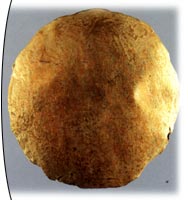 | Name: | An Eye band |
| Type: | Gold |
| Location where it came from: | Kültepe |
| Way of Coming: | Excavation find |
| Dimensions:: | D:4.4 cm |
| Period: | 2000 BC |
An irregular, round, golden sheet with hollow inside is made for closing an eye. Many single or double sheets made of gold, silver and bronze are found in the Kültepe Ib floor graves. The big ones are for placing on the chest.
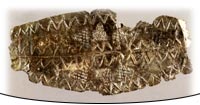 | Name: | An Eye- Mouth Band |
| Type: | Silver |
| Location where it came from: | Akseki |
| Way of Coming: | Purchase |
| Dimensions:: | L:9 cm W:4.4cm |
| Weight: | 1.8 gr. |
| Period: | The 5-4th century BC |
On a silver sheet in an ellipse shape having breaks on the edges has a longitudinal line in the middle and zigzag ornaments on both sides and on the edges. The ornaments of six grape bunches are seen in the middle of the band.
 | Name: | Chest Jewellery |
| Type: | Gold |
| Location where it came from: | Not known |
| Way of Coming: | Not known |
| Dimensions:: | L:13.6cm W.:5.7cm. |
| Weight: | 6.92 gr. |
| Period: | The 5-4th century BC |
The sharp edges of ellipse shaped gold are twisted and rings are attached to the ends. The technique used is repousse. The frame is surrounded with relief points. As ornament, three palms leaves, the one in the middle with stem and the ones on the sides without stem and positioned horizontally, cover almost the whole surface. Smaller leaves of the same type are placed in the empty areas. The leaf veins are visible. There is another ornament (a rosette) on the right lower part of the leaf in the middle, made by pointing. The same type of ornaments is seen on a chest cover found in the Cyprus Enkomi graves.
 | Name: | An Eye- Mouth Band |
| Type: | Gold |
| Location where it came from: | Akça Village |
| Way of Coming: | Excavation find |
| Dimensions:: | L:14cm W:4.7cm |
| Weight: | 3.63 gr. |
| Period: | The Roman |
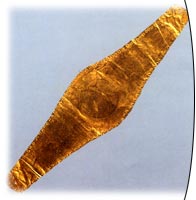 | Name: | A Mouth Band |
| Type: | Gold |
| Location where it came from: | Sandıklı |
| Way of Coming: | Purchase |
| Dimensions:: | L:15.9cm W:4.1cm |
| Weight: | 4.1 gr |
| Period: | The Roman Period |
Its middle part has two sides, it is getting thin towards the ends and its edges are round. The pointing made by hitting the plate on the back forms the frame. There are string passage holes on two ends. There is a small seal or the trace of the coin seal on the sides of the big seal in the middle. Since these seals are indistinct, the details can not be understood.
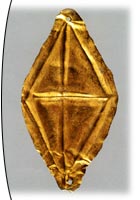 | Name: | A Mouth-Eye Band |
| Type: | Gold |
| Location where it came from: | Maraş, Kürdün |
| Way of Coming: | Purchase |
| Dimensions:: | L:5.7cm W:2.9 cm |
| Weight: | 2.3 gr. |
| Period: | The Roman Period |
The thick golden plates are cut in the form of equilateral quadruples, two more lines forming the vertical and horizontal axis are drawn out of the four lines parallel to the internal side. The ends where there are string holes are cut round. The string holes are opened by pressing a "V" shaped tool against the plate from the back.
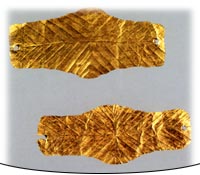 | Name: | A Band (pair) |
| Type: | Gold |
| Location where it came from: | Isparta |
| Way of Coming: | Purchase |
| Dimensions:: | L:6.4cm W:4.5-3 cm |
| Weight: | 2.82gr. |
| Period: | The Late Roman |
It is cut from a thin golden sheet in a form similar to equilateral quadruple. On two sides of the longitudinal line in the middle, from the mid line towards the edges and both sides, lines parallel to each other are made on the plate being drawn on the front and back face in turns. The string holes are positioned closer to the inside of the plate leaving) the short edge and are opened by hitting from the front face.